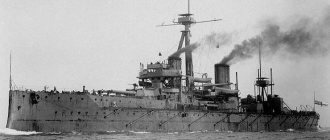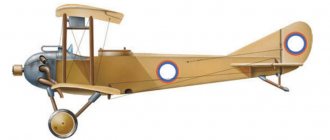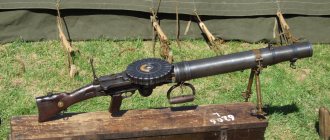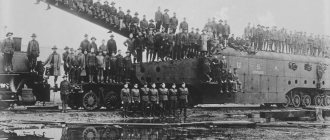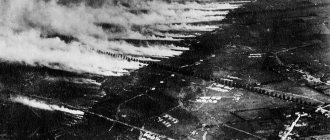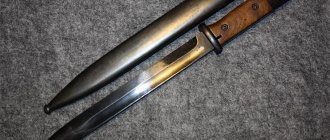Home » Alternative shipbuilding - Fleets that never existed » Fleets of the First World War. French Imperial Navy (Russia Pragmatica II)
Editor's choice Alternative shipbuilding - Fleets that never existed
arturpraetor 01/09/2020 2260
27
in Favoritesin Favoritesfrom Favorites 8
Good day, dear colleagues. I continue to publish information on WWI fleets, and today it’s time for the French Navy. It will talk about changes in financing, a new layout in battleships, the emergence of new classes of ships in the French fleet, and something else.
French Navy in 1914
The first thing you need to know about France in this AI is that it maintained an empire, and after the abdication of Napoleon III and a difficult period in the early 1870s, Napoleon IV Eugene became the monarch. However, this did not cancel political crises, and therefore France comes to 1914, plus or minus, in the same form as in real life. However, there is one important difference - at the beginning of the 20th century, the figure of the emperor nevertheless restored its prestige and authority, and this began to have a positive effect on the situation in all spheres of government activity. This also affected the navy - since 1905, the situation in the ministry and the heads of responsible officials has stabilized there, and the naval forces begin to develop rationally, including in terms of linear forces - no one even thinks of building pre-dreadnoughts, albeit powerful ones, after construction of the Dreadnought itself. The economy is also gaining momentum more than in real life, and although this gives little time to accelerate, it still brings its advantages. But, alas and ah, France, having finally recovered from the Franco-Prussian war and got down to business, in 1914 will be cut off from taking off. What will happen will put an end to any fleet construction for the coming years, and the only source of replenishment for the French will be small combat units leased or built at Allied shipyards. Ships built before the war were relocated to Algeria and Spain, and would continue to fight the Italians and Austro-Hungarians at sea until the very end of the war, showing exemplary fortitude and suffering casualties.
Briefly about the French fleet
The French fleet in the world of Ferrum Autem developed in its own way, in many ways common with our reality, but in many ways distinguishable from it. So, in particular, at one time it also suffered from the “Young School” and funding cuts, but by the time of the “stagnant” 50 years it was already gradually recovering and rebuilding its main forces. Among the tasks of the French fleet, in addition to participating in the Wars of the Holy Alliance and repelling local invasions from the Rifts [1] , there were also coastal defense, control over the colonies and gaining supremacy at sea in the event of a war with the main opponents. These included Great Britain and Germany, but by 988 France was no longer able to field equal fleets against them, and was forced to seek an alliance with other naval powers. Because of this, as well as due to tradition, the French fleet was divided into three parts - Atlantic, Mediterranean and Colonial (aka Pacific). The main features of the French fleet were:
– Insufficient attention to the development of naval aviation. Aircraft carriers are being built, but in small quantities; naval air defense is equipped with small-caliber guns, albeit in twin mounts (officially, to ensure greater fire density).
– Particular emphasis on the development of battleships and light cruisers. The former should become a means of gaining supremacy at sea, the latter, among other tasks, should act against enemy shipping (in particular, German and British). Because of the latter, French destroyers received an increased caliber of artillery, which brought them closer to cruisers.
– Visually, all French ships received an absolutely straight stem without a pronounced bulb – this became a distinctive feature of the entire national shipbuilding.
– French battleships received higher-caliber main battery guns, which caused some damage to their armor and speed. This was partly compensated for thanks to the high technological culture of the French, which made it possible to create a powerful, but light and compact power plant for battleships. Thus, French battleships de jure carry the most powerful main battery guns in the world, while remaining well-proven and cheap to build, and at the same time having relatively balanced characteristics.
– Despite all the problems, the French Navy has a well-developed basing and supply system, as well as a strong reliance on industry and ship repair facilities in the Metropolis, which allows it to maintain a high degree of combat capability on its ships.
– In France, the quality of crew training is traditionally high, but the high degree of involvement of sailors in the political movement in the Metropolis often causes certain problems with discipline, which somewhat reduces the combat effectiveness of ships.
– Among the weak technical aspects of the French fleet are traditionally unreliable fire control systems, which do not allow the full advantage of the 340-mm guns of French battleships to be fully realized at long ranges.
And yes, the fleets do not yet have such secondary classes of ships as mines, minesweepers and auxiliary vessels (like mother ships). As for minzags and minesweepers, I will make them separately, and perhaps even soon. I’m not going to work on auxiliary vessels even close to this yet. Also, new classes of ships may be added to the indicated classes - in particular, flagships (15-16-inch dreadnoughts), cruising submarines (like analogues of the real Surcouf and I-400) and landing ships (like Elpidiforov, paratroopers of Japan and the USA during WWII, or even SDK-BDK during the Cold War, but processed at the level of the early 1920s). Also, a summary table of the performance characteristics of all French artillery may appear later.
Battleships
The French pre-dreadnought and dreadnought mess in AI is completely eliminated, and already in 1906 France begins building its first dreadnoughts. The first of these are the large and powerful (on paper) dreadnoughts, one of the unrealized projects that is now known as the first battleship in the French line in World of Warships. Next come the real types “Courbet” and “Brittany”, laid down before the real one, and, finally, “Normandy”, also laid down earlier. Alas, two Normandy-class battleships would never be completed, and two would only be completed after the end of the First World War.
Type "Turenne", normal displacement 23200 tons, speed 20 knots, armor up to 250mm, armament 12 305/45 mm, 18 100/45 mm guns, 4 450 mm torpedo tubes, crew 1087 people
- "Turenne", 1906/1908/1909
- "Villars", 1907/1909/1910
- "McMahon", 1907/1908/1909
- "Canrober", 1907/1908/1910
Type "Courbet", normal displacement 23475 tons, speed 21 knots, armor up to 270-300mm, armament 12 305/45 mm, 22 138/55 mm guns, 4 450 mm torpedo tubes, crew 1115 people
- "Courbet", 1908/1909/1911
- "France", 1908/1909/1910
- "Jean Bart", 1909/1910/1912
- "Bet", 1909/1910/1911
Type "Brittany", normal displacement 23936 tons, speed 21 knots, armor up to 270-340mm, armament 10 340/45 mm, 22 138/55 mm guns, 4 450 mm torpedo tubes, crew 1124 people
- "Brittany", 1910/1911/1913
- "Lorraine", 1911/1912/1913
- "Provence", 1912/1913/1914
- "Gascony", 1912/1913/1914
Type "Normandy", normal displacement 25230 tons, speed 21 knots, armor up to 300-340mm, armament 12 340/45 mm, 24 138/55 mm guns, 6 450 mm torpedo tubes, crew 1200 people
- "Normandie", 1913/1914/1921
- "Languedoc", 1913/1914/1923
- "Flanders", 1914/not completed
- "Béarn", 1914/not completed
The whirlpool is spinning
The French sailors received orders from Admiral Darlan to preserve their ships at any cost. Or send them to the bottom, preserving the honor of the French flag. This is exactly what they will do in 1942 in Toulon, when there is a threat of the ships being captured by the Germans. In the meantime, the Germans only demanded the disarmament of French ships under their supervision.
The British considered the orders of the command of the capitulating country and the honor of the French sailors to be too dubious a guarantee to entrust their fate to it. And any promises of the Nazis are completely ridiculous. It's hard to blame them for this. "Nothing personal, gentlemen, but freedom and the future of England are at stake."
After some thought and hesitation, the British prepared Operation Catapult. All large French ships remaining on the planet must be captured, neutralized or destroyed.
England expects everyone to do their duty - and don't make such a face, captain. Everyone feels bad, but there is too much at stake.
Battlecruisers
Unlike in reality, France will also build two battle cruisers to lead its light forces before WWI. Without further ado, I simply decided to use my old work on one techno-fantasy AI, and took the ship from there, somewhat reducing the characteristics.
Richelieu type, normal displacement 21,500 tons, speed 28 knots, armor up to 250 mm, armament 8,305/45 mm, 12 138/55 mm guns, 4,450 mm torpedo tubes, crew 819 people
- "Richelieu", 1910/1911/1912
- "Colbert", 1911/1912/1913
Light cruisers
In reality, the French had everything simple with cruisers - they didn’t build them. In AI, this process will begin in 1910, and quite quickly the French are riveting together two series (8 units) of light belt cruisers. As in the case of battlecruisers, I didn’t think long and took two of my old projects of techno-fantasy light French cruisers as a basis, slightly reducing their performance characteristics according to the time. Theoretically, they should have been followed by a third series, but the beginning of WWI and the tragic events of its first months would inevitably put an end to the laying of new buildings.
Type "Tethys", normal displacement 5280 tons, speed 27.5 knots, armor up to 70mm, armament 5 164/50 mm guns, 4 450 mm torpedo tubes, crew 368 people
- "Tethys", 1910/1911/1911
- "La Perouse", 1910/1911/1912
- "Dumont-D'Urville", 1910/1911/1912
Atalante type, normal displacement 7100 tons, speed 28 knots, armor up to 100 mm, armament 8 164/50 mm guns, 4 450 mm torpedo tubes, crew 497 people
- "Atalante", 1911/1912/1913
- "Bougainville", 1911/1912/1913
- "Kerguelen", 1912/1913/1914
- "Cartier", 1912/1913/1914
- "Marseillaise", 1913/1913/1914
Russia
The Russian Federation inherited all the maritime borders of the USSR and most of the great country's navy, but missed the glory of the best fleet in the world. The Russian Navy has a territorial division:
- Pacific;
- Black Sea;
- Baltic;
- Northern;
- Caspian.
The aircraft carrier Admiral Kuznetsov needs modification; the flagship is a nuclear-powered missile cruiser. The main strength of the Russian Navy, according to world military experts, is the submarine fleet. Nuclear submarines are designed to destroy aircraft carriers and ground targets.
Project 955 Borei submarines, equipped with 16 R-30 Bulava SLBMs, will negate the advantages in tonnage and number of ships of any enemy. The large-scale rearmament of the Navy, undertaken in recent years, gives hope for the revival of the naval power of the state.
Other ships
France builds the same number of other ships, with one single exception. First of all, this concerns destroyers, and all additional units will be representatives of the Anseni Rou series - not the most outstanding, but generally reliable “workhorse” for the fleet. In addition, during the war, the French may come into use with various combat boats, but I will not specify their number yet, which is why they are not included in the final table.
South Korea
The South Korean fleet is rapidly increasing its power due to the need to confront its northern neighbor and brother (DPRK). South Korea is one of the economically developed countries of Asia; it uses high technologies in the construction of military ships of various classes and equipping them with the latest weapons.
The country's navy consists of 3 fleets, equipped with Tolgole-class submarines, KSS-II, KSS-III, frigates, and destroyers. There is no nuclear fleet or nuclear weapons in South Korea, but the country's navy is rightfully considered one of the most modern and technologically advanced in the world.


